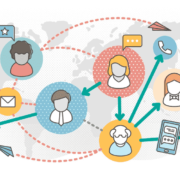Our Senior Living Podcast: The Boss’s Favorite Episodes
Did you know we have a popular senior living podcast called Senior Living Marketing Perspectives? Hosted by our CEO, Debbie Howard, the podcast covers a variety of senior living marketing topics about strategy, technology, and innovation in senior living.
We recently wrapped up our first season, so we asked Debbie to choose some of her favorite episodes. Here are her picks.
Senior Living Podcast Spotlight: A Treasure Trove of Inbound Marketing Best Practices
Are you a HubSpot or inbound marketing junkie? Or maybe you’re new to both terms/concepts? Either way, this episode is for you. Debbie speaks with Dan Tyre, a speaker, blogger, mentor, and coach for those who want to harness the power of inbound marketing to improve their bottom line. Dan joined HubSpot as a member of the original team in 2007 and currently serves as the company’s sales director.
Listen in as Dan unleashes a treasure trove of best practices for today’s inbound marketer, including how to define your persona, qualify prospects, and create an effective sales funnel.
Listen to the complete podcast with Debbie and Dan.
Senior Living Podcast: Creating an Effective Sales Culture in Senior Living during Covid-19
Yes, we’re finally emerging from the pandemic, but we’re going to feel its effects for some time. In this episode, Debbie talks to Mike Miller, President and CEO of Primo Solutions and the author of Selling at Combat Speed and Stop Selling & Start Caring.
In terms of selling during times of uncertainty, Mike says that we have no choice but to “make a difference on the phone.” Even today, it is still possible to increase your conversion rate via deliberate, creative, and empathetic selling. It starts with reducing your marketing spend and putting more focus on training your staff to work with existing leads.
Listen to the complete podcast with Debbie and Mike.
Senior Living Podcast Spotlight: Evaluating Your Digital Presence
Here’s the dirty secret about digital marketing: You’re never done. You need to constantly monitor it—and make adjustments based on what the analytics tell you.
In this episode, Debbie discusses all things digital with Andy Crestodina, co-founder and Chief Marketing Officer at Orbit Media, an award-winning 38-person digital agency in Chicago. They chat about how to manage your community’s online reputation, when to update your site, and how to differentiate yourself with intentional copy.
Listen to the complete podcast with Debbie and Andy.
Senior Living Podcast Spotlight: The Science of Conversions and Optimization
All the time and money you spend optimizing your website doesn’t matter if the optimization efforts don’t result in conversions, right? In this episode, Debbie chats with Brian Massey, Managing Partner at Conversion Sciences, a data-driven conversion optimization agency that seeks to “find those impulses to act that are hidden in your site.”
Brian discusses gems like bounce rate, content strategy, and conversion optimization. This is a great episode to listen to if you want to turn your website into a lead-conversion machine.
Listen to the complete podcast with Debbie and Brian.
Senior Living Podcast Spotlight: Business, Sales, and Marketing Advice
In this episode, Debbie chats with Doug Davidoff, Founder and CEO at Imagine Business Development, a management consulting firm that has worked with over 1500 small and mid-market businesses. Doug is all about offering strategies that help reduce friction between buyers and sellers—something senior living sales reps could definitely use help with.
Doug says, “Your job is not to sell the community. Your job is to help somebody make a good decision about where they should spend their senior years.” With sales and marketing working in tandem, operating by the principles of empathy, the entire process becomes smoother. As Doug says, “The single best thing a company can do to increase sales is to make it easier for someone to buy.”
Listen to the complete podcast with Debbie and Doug.
Senior Living Podcast Spotlight: Adopting New Technology to Promote Well-Being
This episode features Hollie Kemp, Chief Operating Officer at Sagely, a Honolulu-based IT company that “marries the power of software, data, and the human element to empower caregivers, elders, and their families to improve elders’ well-being.”
Using technology to boost engagement with seniors has been an incredibly popular topic this past year, thanks to the pandemic. What we love about Hollie’s perspective is that she doesn’t see technology as a replacement for people within the senior living industry. Hollie says, “I still think we’re a human business. Technology just enables the human to do their job better.”
We couldn’t agree more! We always remind our clients that whenever we recommend any sort of technology, from marketing automation to Facebook Live, the goal is to enhance the human-to-human interactions, not replace them.
Listen to the complete podcast with Debbie and Hollie.
Senior Living Podcast Spotlight: Welcome Home – A CRM Platform Designed Specifically for Senior Housing and Care
If you’ve been on the hunt for a senior living CRM, Welcome Home is a great option. In this episode, Debbie talks to the founder of Welcome Home, John Lariccia, who designed the platform specifically for senior housing and care.
John developed Welcome Home because traditional CRM technologies did not adequately account for the complexities of the human element of closing sales that is especially important in senior living.
One of the best things about this CRM? No wasted functionality. Teams use all of it. The CRM is also incredibly intuitive (which saves on training costs).
Listen to the complete podcast with Debbie and John.
Senior Living Podcast Spotlight: Today’s Prospects Have a Greater Sense of Urgency About Their Senior Living Options
Too many senior living websites are nothing more than online brochures. But an interactive survey tool called Roobrik aims to engage website visitors while gaining data on them that helps Roobrik provide even more valuable info—info that will empower visitors to make the best decisions for their situation.
In this episode, Debbie chats with Nate O’Keefe, Founder and CEO of Roobrik, about the effectiveness of gathering data and building trust via anonymous “conversational assessments” and how the pandemic has affected people’s decision-making when it comes to senior living.
Listen to the complete podcast with Debbie and Nate.
Senior Living Podcast Spotlight: A Down-to-Earth Chat with Elder Resource Benefits Consulting
This is SUCH an important topic for senior living sales teams to be aware of—but more than that, it’s a great resource to have prospective residents and families listen to.
In a nutshell, Debbie talks with Patty Servaes, a VA-accredited agent and the founder of Elder Resource Benefits Consulting. ERBC was founded in 2005 to help seniors navigate different benefits that are available to them. Its specialty is the VA’s Basic Pension with Aid and Attendance Benefits. The company focuses on veterans getting the VA’s Pension Benefit as quickly as possible as soon as they are eligible for it. Definitely an episode to bookmark and share with seniors and their families, as needed.
Listen to the complete podcast with Debbie and Patty.
Browse all of our senior living podcasts.
The episodes above are just a sampling from this season. To learn more about all the episodes, download our guide, which includes notes on each podcast and links to episodes, speakers, and more.












